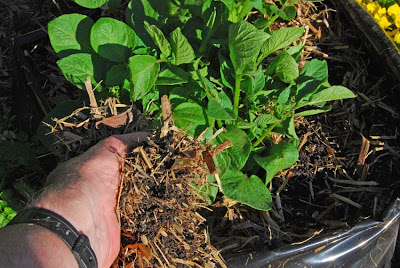When they're young, there's nothing more cheerful than potato plants. What a picture of rude green health they are. It was only back on September 8 that I did a blog on bagging up spuds, having planted them just two weeks earlier. And now, on September 27 the spuds have roared away and the tallest plant is 35cm high already. They're all very green, thriving in their planter bags, and ready for a spot of 'hilling'.
 Here's the happy crew this morning, spreading green cheer. However, they've grown so fast it's time to do a spot of 'hilling', or at least the bagged potato version.
Here's the happy crew this morning, spreading green cheer. However, they've grown so fast it's time to do a spot of 'hilling', or at least the bagged potato version. After unrolling the sides of the bag by five or six inches I then filled the bag, and around the plants, with a mix of compost and straw. This 'hilling' is important, as it stops sunlight ever getting onto the crops of potatoes which form around the stems of the plants. Sunlight on spuds will make them green and poisonous, so hilling is an essential part of spud farming.
After unrolling the sides of the bag by five or six inches I then filled the bag, and around the plants, with a mix of compost and straw. This 'hilling' is important, as it stops sunlight ever getting onto the crops of potatoes which form around the stems of the plants. Sunlight on spuds will make them green and poisonous, so hilling is an essential part of spud farming. The mixture is actually compost and sugar cane mulch, the same stuff I use to mulch the garden. I think it's mixed up around 50:50 proportions, but it doesn't really matter. I know I probably don't have enough compost left over to fully fill both potato bags, so I'm using the mulch as an 'extender'. Reading online, I've noticed that some gardeners grow their spuds in nothing but straw and they still get good crops, but I think the richness of the compost surely helps. It certainly seemed to help with last year's potato crop.
The mixture is actually compost and sugar cane mulch, the same stuff I use to mulch the garden. I think it's mixed up around 50:50 proportions, but it doesn't really matter. I know I probably don't have enough compost left over to fully fill both potato bags, so I'm using the mulch as an 'extender'. Reading online, I've noticed that some gardeners grow their spuds in nothing but straw and they still get good crops, but I think the richness of the compost surely helps. It certainly seemed to help with last year's potato crop. This is how the bags look after the hilling. I guess that I'll have to do one more 'top up' of compost and straw in a few more weeks, as there's about six more inches of bag to unfurl.
This is how the bags look after the hilling. I guess that I'll have to do one more 'top up' of compost and straw in a few more weeks, as there's about six more inches of bag to unfurl. So far so good with this year's little crop. In fact, this year's spud crop has grown even more vigorously than last year's, but they are different spud varieties I am growing this year, and this might explain the amazing growth. Also, it has been warmer this spring than last year, so that might also have a lot to do with it. Whatever the cause, the ugly black plastic bags full of spud plants are a cheerful, pleasing sight. I'm looking forward to seeing a good array of those pretty, simple white potato flowers next, and at the current rate of growth it might be sooner, rather than later.














































